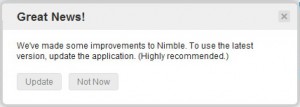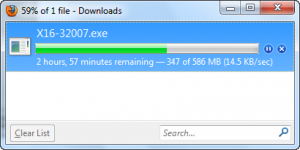Nimble (www.nimble.com) announced a new version this past week with some significant improvements. Their announcement reminded me of one of the many reasons why I love Cloud/SaaS software like Nimble – because I simply use it – I don’t have to maintain it. Vendors release software updates periodically to correct defects and add functionality. They’re
October 5, 2012
Nimble (www.nimble.com) announced a new version this past week with some significant improvements. Their announcement reminded me of one of the many reasons why I love Cloud/SaaS software like Nimble - because I simply use it - I don't have to maintain it. Vendors release software updates periodically to correct defects and add functionality. They're often referred to as Hot Fixes, Service Packs, Patches or Updates. And vendors release new versions of software, called upgrades, some as often as every year. The difference between Cloud/SaaS software and On Premises software is the amount of effort on your part to take advantage of these updates and upgrades. For example, one popular SaaS CRM vendor releases, on average, 4 new 'releases' each year while a popular On Premises CRM vendor releases a major new version every year, followed by an average of 2 Service Packs and 6 Hot Fixes - that's 1+2+6= 9 updates/upgrades in a 12 months period. The issue is not how often these are released, but how much effort or expense does it take you to implement these new releases. Consider the following:How to upgrade to the latest version of Nimble:


- Log into Nimble. If it says "Great News!", click Update.
- After it completes, use Nimble as usual and enjoy the new features.

- First, you have to know there's an update or upgrade, perhaps you were experiencing an error, and Tech Support or a Forum or a Consultant suggested you update or upgrade, possibly because it might fix a problem you were experiencing. Oft times, Tech Support will tell you to update, not because they know with certainty that it will resolve your particular problem, but because they have to eliminate all obvious reasons,
- Next, find and download the right update, upgrade, Service Pack or Hot Fix for your version, and make sure it's for your version, and not an earlier or later version. Remember that with some Vendors you won't be able to get updates or upgrades for your current version unless you're on a paid support plan. And that's will typically cost you, on average, 20% of the original cost of the software, annually. And if you don't upgrade regularly, you'll find the vendor often stops releasing patches and updates after one year or so, instead focusing on this year's version,
- Make sure you apply the update to ALL computers simultaneously - usually, all computers must be at the exact same version,
- Launch the software because it may have to update your data. And don't forget to backup your data before you allow it to update in case anything goes wrong,
- Be on the lookout for new defects, or better yet, don't be the first to update, let others test the updates and patches and spend precious time testing the vendors' patches, something they no longer focus on.
Leave a Reply